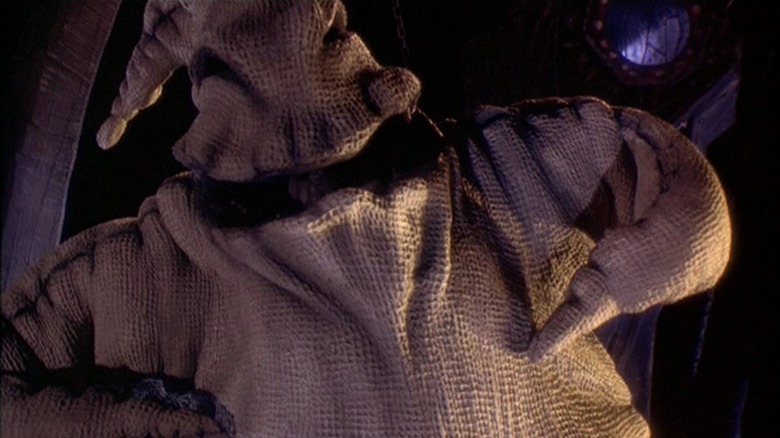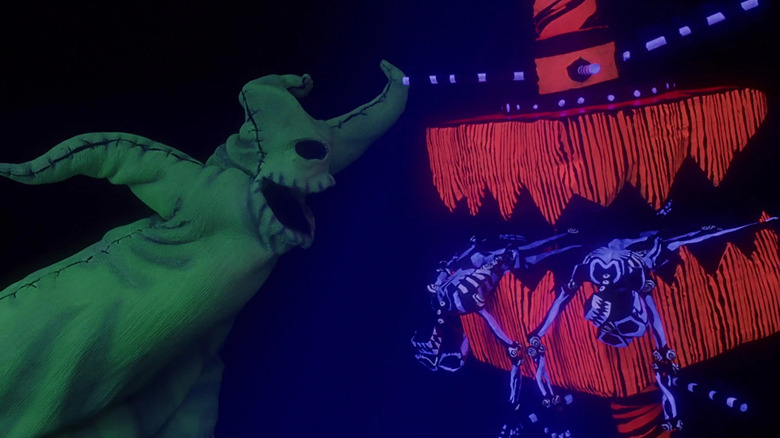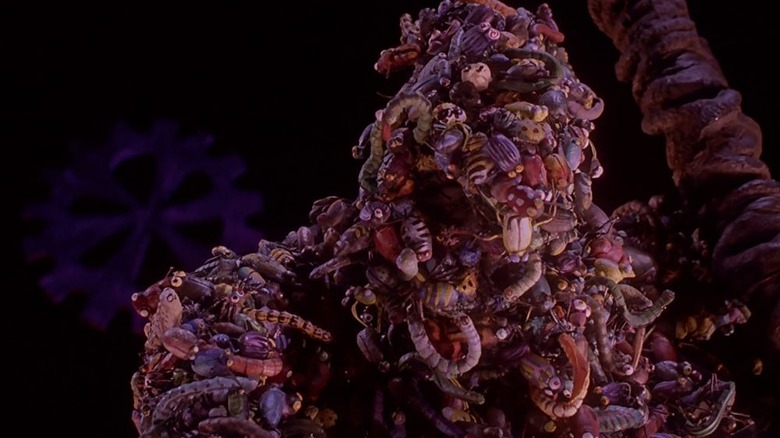This Nightmare Before Christmas Character Was By Far The Most Challenging To Create
In a Halloween world where every person is a monster, a vampire, a skeleton, a werewolf, a demon, or a creature that hides under the stairs, who could possibly be a villain? In Henry Selick's 1993 stop-motion animated fantasy "The Nightmare Before Christmas," Jack Skellington (Chris Sarandon speaking, Danny Elfman singing) is the community's most famous local hero, but he is not a killer. Indeed, Jack seems to be good-hearted (if he had a heart) and secretly longs for romance. The local mad scientist Dr. Finkelstein (William Hickey) can resurrect dead skeletons, but he doesn't want to take lives. Even the two-faced Mayor (Glenn Shadix) is more ineffectual than evil.
The only monster in Halloween Town that truly longs for violence and aches to kill people with his own hands is Oogie Boogie, a.k.a. the Boogeyman (Ken Page). As imagined by the film's designer, Tim Burton, Oogie Boogie is a large, empty-eyed burlap sack full of bugs and snakes. He only barely has a humanoid shape and lurches toward his victims with a cackle and a Cab Calloway-style musical number. Oogie Boogie lives in a mechanical casino underneath the home of Lock (Paul Ruebens), Shock (Catherine O'Hara), and Barrel (Elfman), who feed him victims.
The characters in "The Nightmare Before Christmas" were all constructed of moveable maquettes. The Jack Skellington models were about 16 ½" tall but were spindly enough to have his entire head or faceplate removed to achieve the stop-motion expressions. Oogie Boogie, conversely, was a massive, round model that took a lot more time to sculpt and animate. According to David A. Bossert's new book "The Nightmare Before Christmas Visual Companion," Oogie Boogie was the toughest job for the staff.
The layer of latex
In Bossert's book, the process for creating the Boogieman model is explained in detail. For many of the characters in "The Nightmare Before Christmas," a poseable skeletal armature was built, and foam latex "flesh" was piped in around it. If one looks closely at some of the characters' elbows, especially on a Blu-ray, one might see some of the latex bunching up during certain arm movements.
Oogie Boogie, however, had a teardrop-shaped body, stubby legs, and tentacle-like arms. Because of the model's sheer bulk, a solid foam rubber exterior would not have been practical; it wouldn't have bent properly. As such, the filmmakers instead made a foam rubber bag, Oogie Boogie's skin, and stuffed it with cloth, giving it the appropriate "squishy" look. Then it was painted and brought to set.
Animator Allison Abbate, who worked on "The Rescuers Down Under" and "The Little Mermaid," met Tim Burton on "Nightmare," and would go on to produce his other animated films "Corpse Bride" and "Frankenweenie." She worked extensively on the Oogie Boogie puppet and remembers the headaches. Working with foam latex, it seems, requires a lot of special care. Anyone who has touched it knows its fickle density and tendency to flake over time. It was also a matter of making sure Oogie Boogie's skeleton didn't get gluey inside the latex sack. She said:
"It is an art form in and of itself just how to get the foam just right. The density had to be just right so that you could move the puppet and it wouldn't get too stiff."
I'm your Boogieman, I'm your Boogieman. Turn me on.
At the end of the film, as the Boogieman faces off against Jack Skellington in his underground casino over the fate of Santa Claus, one of his threads starts to come loose. Jack pulls on it, unraveling the Boogieman's stitching, causing his sack to be ripped off. Underneath, the Boogieman is a massive pile of insects, maggots, and centipedes. Don't look too closely, or you may become a little grossed out. According to "Nightmare Before Christmas" model maker Bonita R. DeCarlo, the bug body was one of three Boogieman models made foe the film. One was the sack-colored model to be used in shots with white lighting. A second was painted green to stand out in the scenes lit with ultraviolet lights. And the third was the bug being, easily the most complex model used in the whole movie.
DeCarlo pointed out that the Boogieman's bug "skin" was constructed of 3,000 separate little bug entities, with many of them needing to be animated to provide a realistic "squirm." There were 30 bug models, with 100 copies made of each, and with each one being hand-painted. The Boogieman's death scene lasts only about ten seconds, but it is a ten seconds that will burn its way into a viewer's memory. "Look what you've done!" the Boogieman yells. "My bugs! My bugs!" He repeats his plea as his big body collapses and insects fall into a pit of molten glop below him. The final insect is dispatched by Santa Claus' boot.
In 2018, three of Oogie Boogie's screen-used bugs were sold at auction.


